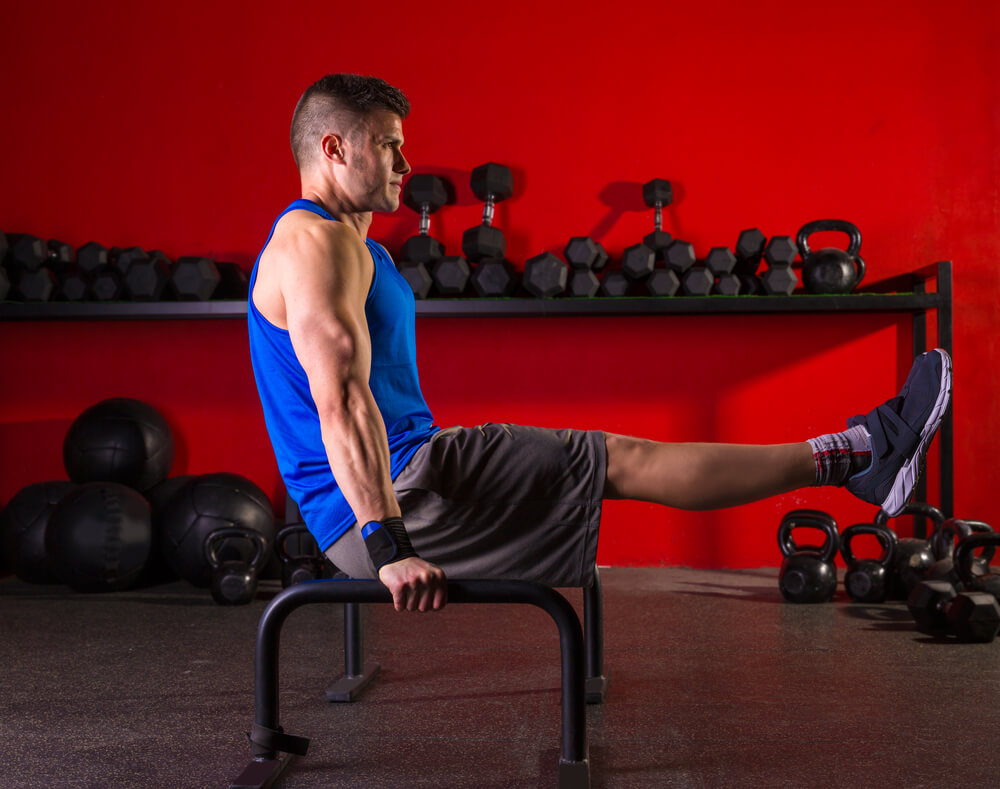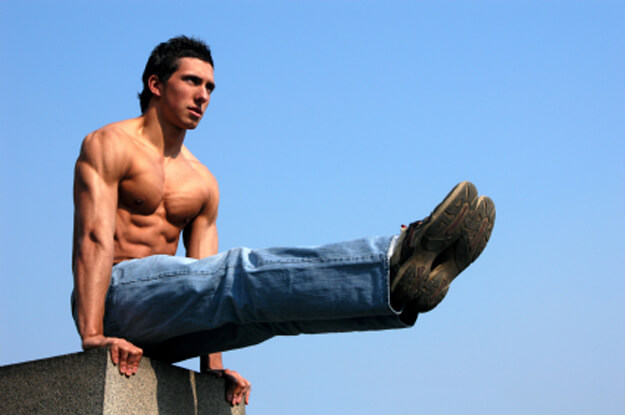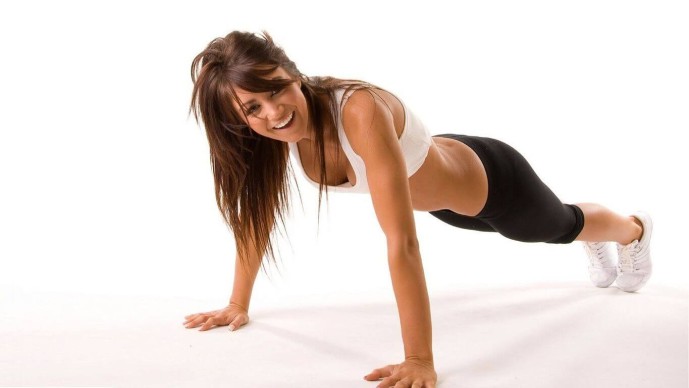
Ever wondered how you can build more muscle and get pumped with bodyweight training alone?
You’ll be surprised how effective these bodyweight exercises can be for maintaining your muscle and fitness.
Here’s how:
Instead of requiring you to invest in an assortment of weights, body-weight exercises rely on your own body as the source of resistance for muscle-building activities. If you want to add significant bulk, you may need to graduate from body-weight activities to weight training, but if you’re just looking to get in better shape, a body-weight routine could be all you need.
Bodyweight Training Benefits:
- Free
- Versatile, many different variations
- Can be done anywhere
- Improves movement
- Improves relative strength
- Can improve reactive strength
There are four questions I get asked when it comes to bodyweight workouts.
- Is bodyweight training as effective as weightlifting?
- Do you have a good bodyweight workout?
- Can you build muscle and strength with bodyweight exercises alone?
- Should you combine bodyweight exercises with your weightlifting?
In this article, I’ll address these frequent questions and others, as well as share with you what I feel is the “ultimate” bodyweight workout routine.

Major benefits of body weight training:
Convenience and Portability
Bodyweight exercises require no financial investment, which means you don’t have to wait to exercise until you’ve paid down debt or built a savings account. Because a routine that solely relies on your body weight requires no equipment, you can do it virtually anywhere, which means a long day at the office or a vacation are no longer excuses to avoid exercise.
Aerobic Exercise:
Aerobic exercise that gets your heart pounding is the key to burning calories and plays a significant role in reducing your risk of cardiovascular health problems. You can get a moderate aerobic workout from your bodyweight routine if you increase your pace by, for example, doing squats for five minutes rather than aiming for a particular number of reps. Of course, you’ll still need focus on proper form, which means that if you’re not in good physical shape, you may have to build up to bodyweight cardio.
Better Mental Health:
It’s not secret that working out is great for your mood and mental well-being. According to the U.S. Center for Disease Control and Prevention, regular strength-building activities such as bodyweight exercises can help improve your mood and may even reduce your risk of conditions such as depression.
Better Physical Health:
Your risk of osteoporosis, arthritis, diabetes, cancer and similar ailments tends to increase as you age. The CDC reports that weight-training exercise can help reduce your risk of a wide variety of such conditions. For the best benefits, perform body-weight exercises that work every major muscle group at least three days per week.
Incidental Training:
When you bench press you obviously hit your pecs, deltoids and triceps. However, if you flip over onto your stomach and crank out some one-arm pushups, you now have incidental training happening. Apart from your pecs, deltoids and triceps getting amped, your lats turn on to protect your shoulder, your abs fire to stop your hips from sagging, and your quads and hamstrings ignite to keep your legs straight. All this adds up to a lot more time under tension which will result in greater muscle growth.
Greater Neuromuscular Demand:
Whenever you move your body through space there is a greater neuromuscular demand on the body; this means that the brain will recruit more muscle fibers, which will result in greater strength and muscle gains on a pull up as opposed to a lat pull down. Both are the same movement, but pull-ups require your entire body to move through space as opposed to just your limbs on the lat pull down.
Don’t believe me? Take a look at gymnasts, these are by far the most jacked, ripped and strongest athletes in the world (sprinters are up there too). All gymnastic work is bodyweight training, not to mention adding in rings and bars and training 6-7 times a week with full body workouts. Quite frankly, I think one arm pushups are more badass than a bench press.

THE ULTIMATE BODYWEIGHT WORKOUT FOR BODYBUILDERS
Bodyweight workout routines are a cost and time effective way to lose excess fat and build muscle and strength.
Bodyweight Workouts vs. Weightlifting:
Which is Best For Building Muscle Size and Strength?
Here’s the catch: whether we are talking about strength gains or hypertrophy (getting big), one of the major principles at play is progressive overload.
Progressive overload is the gradual process of adaptation that takes place in the body when increasing stress is placed upon it in the form of heavier loads. And unsurprisingly, progressive overload does not discriminate: whether you lift iron or your own bodyweight, at equivalent weight (or mechanical disadvantage) your strength or hypertrophy gains should be exactly the same.
Proponents of weight lifting will argue that it is much simpler and smoother to keep adding small loads to a barbell, than to keep coming up with bodyweight exercise variations to increase the stress placed on the body.
On the other hand, bodyweight exercise progressions can also be fine tuned, and they can offer a very gradual way of increasing the difficulty of a given exercise…
– Progressive overload is achieved through incrementally adding small loads to exercises. Progressions are very smooth, and the basic mechanics of the exercises remain the same.
– Big compound movements are often closed kinetic chain exercises (which are considered safer), but isolation exercises (and also a few compound lifts) fall under the ‘open kinetic chain’ category, which somewhat increases the amount of shearing forces placed on the joints.
– Using a greater variety of isolation exercises means you have more control over the way your body looks and develops than with bodyweight exercises. These isolation exercises are seldom used in beginners workout however. This is also where the “art of bodybuilding” comes down to the specific focus an athlete poses on the various parts of the body.
Bodyweight Training:
– Progressive overload is achieved through exercise variations, making use of leverage and mechanical disadvantage. Progressions are perhaps not as smooth as in weightlifting, but the constant changes from one exercise variation to the next targets muscles from different angles.
– Most exercises are closed kinetic chain exercises and these are generally considered safer and more functional. It is worth noting however that some advanced movements such as back levers and one arm chins place a lot of stress on tendons and connective tissue of the joints involved.
– CNS gains reoccur frequently: the constantly changing nature of exercise progressions means that each variation has slightly different mechanics than the previous one (basic programs consist of often well over 50 different variations of 6 or 7 basic exercises). These constant changes place far greater demands on coordination, proprioception, balance and flexibility than weightlifting does. Rapid CNS gains therefore happen with each new variation, arguably resulting in increased strength and muscle mass.
– Most exercises are compound exercises, which are widely considered to favor muscle growth far quicker than isolation exercises.
Whilst weight lifting may have a slight advantage over bodyweight training in the sense that progression is smoother, bodyweight training makes up for this with its greater variety, balance, agility, and flexibility gains. For all intents and purposes though, in the context of a beginner to intermediate program, the difference between the two in terms of strength and muscle mass increase should be negligible.
Verdict: Why Choose?
The endless debate about weights vs. bodyweight exercises is mostly a theoretical one Countless weight lifters perform bodyweight exercises (from pull ups and dips to explosive movements like clap push ups), so why wouldn’t bodyweight athletes do the same and use weights, weighted vests, or gallon bottles of milk, when it suits their needs? Variety is always a good thing in any training program.
Choosing between weights and bodyweight, in my mind, is just like choosing between peas and carrots: it’s not about which is most nutritious, but merely a matter of taste and/or what’s available… And if you can have both… well, they’ll get along just like peas and carrots!
The Ultimate Bodyweight Workout Equipment
Weighted Workout Vest
This vest allows you to add up to 40 lbs to your body, which allows you to get more “miles” out of the workouts due to the progressive overload theory discussed earlier.
For instance, you will work on your wide-grip pull-ups until you can do 8-10, and then you will add 10-15 lbs using this vest, which will bump you back down to the 5-rep range, and you can continue from there.
Pushup Bars & Kettle-Bells
You typically perform push-ups with your hands on the floor, but using push-up bars or handles can offer a couple of training benefits. If you suffer from wrist discomfort, the apparatus allows you to perform the exercise without pain. In addition, using a push-up bar lets you lower yourself closer to the floor, increasing how hard your muscles work.
You’ll also need some weights to go with the belt. I prefer kettle-bells because you can hang them off the belt and also use them for arms and shoulder training.
If you’re going this route, I’d recommend a 20 lb, 35 lb, and another 35lb or two 50 lb kettle-bells for squatting.
Power Tower or Pull up Bar and Dip Station
A good bodyweight workout program includes pull-ups and dips, and a “Power Tower” kills both birds with one stone. It also allows you to perform hanging and captain’s chair leg raises, which are great ab exercises.
Here are a couple other items that can be very useful:
Ab wheel – The ab wheel is a simple, effective way to train your abs, and it’s cheap.
Medicine ball – This is an optional item, but a nice addition for both men and women.
Workout mat – It’s cheap, and if you’re setting everything up inside, it will protect your floor from scuffs and dents.
Battle Rope Workout Bar – The bar can also be used to add a little weight to your squats.
Choose one or the other, unless you really want both (the rope for the rows, and the bar for adding weight to your squats).
Workout bands – Workout bands have various uses, as you know, but the primary use of them in this program will be to assist with your pull-ups and dips.
WORKOUT ROUTINE
Suspended One-Arm Chinup
Reps: 40 total, Rest: 60–90 Seconds
Attach a suspension training apparatus (we like the jungle gym, as shown here) to a sturdy object and lower the handle to your sternum. Grab the handle and hang with your knees bent and feet on the floor (A). Pull yourself up, using assistance from your legs as needed (B). That’s one rep.
Resisted Pushup
Reps: 40 total, Rest: 60–90 Seconds
If you cannot do two sets of 20 regular pushups, stick with pushups until you can. Otherwise, use an elastic exercise band or the Power Pushup apparatus, as shown here. Let the cables resist the pushup motion and perform reps as normal.
Suspended Leg Curl
Reps: 40 Total, Rest: 60–90 Seconds
Attach a suspension training apparatus as you did for the one-arm chinup and hook your feet into the handles. Lie on your back on the floor and extend your hips so that your lower body is suspended in the air (A). Bend your knees, curling your legs toward you (B). Straighten your knees. That’s one rep.
Squat Jump
Reps: 40 Total, Rest: 60–90 Seconds
Stand in an athletic stance, and then squat as deeply as you can while keeping your lower back in its natural arch. Let your hands hang at your sides so your fingers touch the floor in the bottom position (A). Immediately jump as high as you can, reaching for a mark that’s 12 to 24 inches above your reach when standing (B). That’s one rep. Perform as many reps as you can until you begin to slow down or can no longer touch your mark.
Ab Wheel Rollout
Reps: 40, Rest: 60–90 Seconds
Hold an ab wheel (we like the Power Wheel, shown here) with both hands and kneel on the floor with the wheel in front of your shoulders (A). Keeping your abs and hamstrings braced, roll forward as far as you can until you feel your lower back is about to sag (B). Roll back up. That’s one rep.
Chinup
Sets: 3, Reps: As many as possible, Rest: 60–90 Seconds
Hang from a chinup bar with your hands shoulder-width apart and palms facing you (A). Pull yourself up until the bar is at your collarbone (B). Lower yourself back down. That’s one rep.
Conclusion
You can build larger and stronger muscles with bodyweight training and circuit training with the routine mentioned above. Remember that variation keeps your muscles guessing and that your diet and rest are the deciding factors in your progress.
-Terry Asher
Terry
Latest posts by Terry (see all)
- How Important Are Net Carbs For Building Huge Muscle? - Apr 28, 2017
- The Matt Damon Workout Explained - Apr 27, 2017
- Watercress – Benefits And The Best Way To Consume It - Apr 26, 2017











Very nice post. I am really glad to see these types of post which is very helpful for me to build my muscles. Will definitely add these tips in my workout.
Thanks for stopping by Mohammad!Glad you enjoyed it!
Terry Asher
Great article! I will test it in my workouts, thanks
Tim thanks for stopping by!
-Terry Asher